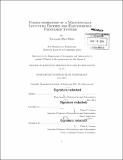| dc.contributor.advisor | Paulo C. Lozano. | en_US |
| dc.contributor.author | Mier Hicks, Fernando | en_US |
| dc.contributor.other | Massachusetts Institute of Technology. Department of Aeronautics and Astronautics. | en_US |
| dc.date.accessioned | 2014-10-08T15:28:45Z | |
| dc.date.available | 2014-10-08T15:28:45Z | |
| dc.date.copyright | 2014 | en_US |
| dc.date.issued | 2014 | en_US |
| dc.identifier.uri | http://hdl.handle.net/1721.1/90781 | |
| dc.description | Thesis: S.M., Massachusetts Institute of Technology, Department of Aeronautics and Astronautics, 2014. | en_US |
| dc.description | Cataloged from PDF version of thesis. | en_US |
| dc.description | Includes bibliographical references (pages 81-82). | en_US |
| dc.description.abstract | Small satellites are changing the space scene dramatically. By drastically reducing costs while still having impressive technological capabilities, their popularity among the space community is increasing at a very fast rate. Propulsion systems for these class of spacecraft are very limited. One promising technology is the ion Electrospray Propulsion System (iEPS) developed at the Space Propulsion Laboratory at MIT. Electrosprays accelerate ions present in the interface between an ionic liquid and vacuum using strong electric fields. Current thrust estimates for the iEPS modules land in the vicinity of tens of [mu]Newtons. Measuring the small thrust produced by the devices is challenging to say the least. This thesis presents the design and development of a Magnetically Levitated Thrust Balance (MLTB) for thrust estimation of the iEPS devices. The MLTB levitates an engineering model of a small satellite using magnetic fields inside a vacuum chamber. The zero friction environment is exploited to measure the minute thrust levels produced by the electrospray thrusters. Additional sensors and actuators that provide added functionality to the instrument are also explained. A fully stand-alone Power Processing Unit (PPU) capable of generating and delivering the high voltage signals needed to drive the thrusters is explained in detail. Test results of charging behavior and lifetime characterization of the emitted current are presented as a preliminary exploration of these processes. | en_US |
| dc.description.statementofresponsibility | by Fernando Mier Hicks. | en_US |
| dc.format.extent | 82 pages | en_US |
| dc.language.iso | eng | en_US |
| dc.publisher | Massachusetts Institute of Technology | en_US |
| dc.rights | M.I.T. theses are protected by copyright. They may be viewed from this source for any purpose, but reproduction or distribution in any format is prohibited without written permission. See provided URL for inquiries about permission. | en_US |
| dc.rights.uri | http://dspace.mit.edu/handle/1721.1/7582 | en_US |
| dc.subject | Aeronautics and Astronautics. | en_US |
| dc.title | Characterization on a magnetically levitated testbed for electrospray propulsion systems | en_US |
| dc.type | Thesis | en_US |
| dc.description.degree | S.M. | en_US |
| dc.contributor.department | Massachusetts Institute of Technology. Department of Aeronautics and Astronautics | |
| dc.identifier.oclc | 891568158 | en_US |
